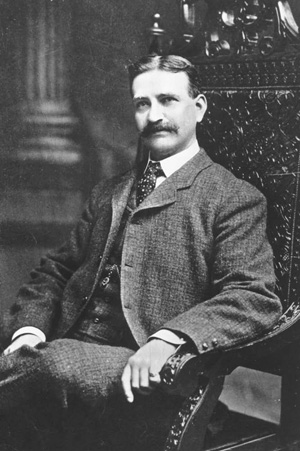BAUM, L. FRANK (1856-1919)

L. Frank Baum, ca. 1900
View largerNine years before he wrote his first children's book, Lyman Frank Baum followed the frontier promise of prosperity to Dakota Territory, embarking on an experience that would contribute greatly to the themes and scenes of his great American fairy tales about the Land of Oz. Critics have long noted that The Wizard of Oz (1900) celebrates the values of the agrarian heartland and provided the nation with its first recognizably American (as opposed to European) fairyland. The book and its author have also had lasting impacts on the culture and image of the Great Plains region, from Kansas to North and South Dakota.
Born into a wealthy family in Chittenango, New York, on May 15, 1856, Baum sampled a variety of careers, most involving writing and publishing. When he married Maud Gage, the youngest daughter of national suffãrage activist Matilda Joslyn Gage, the couple settled in Syracuse, New York, before the birth of the first of their four sons in December 1883. For the next five years Baum worked in a family business that made axle grease. When the business, like many of his earlier enterprises, failed, Baum looked around for new opportunities. In the early 1880s many of Baum's neighbors, among them members of his wife's family, had headed west to participate in Dakota Territory's boom (1879-87). After a whirlwind trip to the area in September 1888 Baum packed up his family and moved to Aberdeen, a county-seat town in the northeastern corner of what is now South Dakota, where he established Baum's Bazaar to sell a wide variety of luxury goods just as the Dakota boom ended.
By the winter of 1889 drought conditions had brought actual starvation to parts of Dakota, and during the next five years almost 3,000 people abandoned the Aberdeen service area. Baum's Bazaar failed, and in January 1890 Baum took over the weekly newspaper of a fellow Syracuse transplant and began a fifteen-month career as western editor and job printer. His Aberdeen Saturday Pioneer reveals in depth his attitudes about politics, suffrage, tolerance, and religion, offering an important key to the themes that later surface in Baum's fiction, especially his fourteen Oz books.
The year 1890 provided an incredible range of events for an observant editor to comment upon. South Dakota had become a state on November 2, 1889, and the political events of its first year included the formation of an independent party that would evolve into the Populist Party. A campaign to give women the vote brought national personalities such as Carrie Chapman Catt and Susan B. Anthony to stump the state for suffrage, while the Ghost Dance movement among the Lakotas attracted Gen. Nelson Miles and Buffalo Bill Cody. Temperance advocates and liquor dealers exchanged heated rhetoric on the issue of prohibition. To contribute barbed comments to the political brew, Baum created a weekly satirical column entitled "Our Landlady." In April 1891, however, economic conditions forced the editor and his family to join the exodus from Dakota.
From Aberdeen Baum went to Chicago, where he worked as a newspaper editor, crockery salesman, and editor of a trade journal before beginning to write children's books at the age of forty-one. From 1897 until his death in Hollywood, California, on May 5, 1919, Baum wrote more than seventy books, many under pseudonyms, but it is The Wizard of Oz (1900) that is most important. In it Baum created a fairy tale that has become a cultural symbol, largely through adaptation to stage and screen (beginning with a musical comedy in 1902). Its characters, attitudes, and values are all distinctly American. Unfortunately, its depiction of Kansas as a drab, droughtstricken hinterland has affected the region for years. On the positive side, the book also created Dorothy Gale, a strong heroine who embodies the assertiveness and ability of those who settled the Plains.
The Wizard of Oz also contains an allegorical commentary on American politics and the Populist movement of the Great Plains region. The other Oz books, the next of which is The Marvelous Land of Oz (1904), continue the tradition of strong female characters and add allegorical commentary on women's rights and utopian concepts. The Dakota prairie and its wildlife–prairie dogs, bison, gophers, crows, and grasshoppers–also provided the setting and characters for some of Baum's shorter fiction, his "Animal Fairy Tales," which appeared in the Delineator in 1905, and the "Tinkle Tales," a series of small books for younger children that appeared in 1906 and 1907.
See also FILM: The Wizard of Oz / IMAGES AND ICONS: Gale, Dorothy / POLITICS AND GOVERNMENT: Populists (People's Party).
Nancy Tystad Koupal South Dakota State Historical Society
Baum, Frank Joslyn, and Russell P. MacFall. To Please a Child: A Biography of L. Frank Baum, Royal Historian of Oz. Chicago: Reilly and Lee, 1961.
Baum, L. Frank. Our Landlady, edited and annotated by Nancy Tystad Koupal. Lincoln: University of Nebraska Press, 1996.
Koupal, Nancy Tystad. "The Wonderful Wizard of the West: L. Frank Baum in South Dakota, 1888–91." Great Plains Quarterly 9 (1989): 203–15.
XML: egp.lt.003.xml